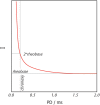Anti-inflammatory polymer electrodes for glial scar treatment: bringing the conceptual idea to future results
- PMID: 24860493
- PMCID: PMC4026681
- DOI: 10.3389/fneng.2014.00009
Anti-inflammatory polymer electrodes for glial scar treatment: bringing the conceptual idea to future results
Abstract
Conducting polymer films offer a convenient route for the functionalization of implantable microelectrodes without compromising their performance as excellent recording units. A micron thick coating, deposited on the surface of a regular metallic electrode, can elute anti-inflammatory drugs for the treatment of glial scarring as well as growth factors for the support of surrounding neurons. Electro-activation of the polymer drives the release of the substance and should ideally provide a reliable method for controlling quantity and timing of release. Driving signals in the form of a constant potential (CP), a slow redox sweep or a fast pulse are all represented in literature. Few studies present such release in vivo from actual recording and stimulating microelectronic devices. It is essential to bridge the gap between studies based on release in vitro, and the intended application, which would mean release into living and highly delicate tissue. In the biological setting, signals are limited both by available electronics and by the biological safety. Driving signals must not be harmful to tissue and also not activate the tissue in an uncontrolled manner. This review aims at shedding more light on how to select appropriate driving parameters for the polymer electrodes for the in vivo setting. It brings together information regarding activation thresholds for neurons, as well as injury thresholds, and puts this into context with what is known about efficient driving of release from conducting polymer films.
Keywords: conducting polymer; dexamethasone; drug delivery; glial scarring; neural interfaces.
Figures



Similar articles
-
Electrochemically Controlled Drug Release from a Conducting Polymer Hydrogel (PDMAAp/PEDOT) for Local Therapy and Bioelectronics.Adv Healthc Mater. 2019 May;8(10):e1801488. doi: 10.1002/adhm.201801488. Epub 2019 Mar 5. Adv Healthc Mater. 2019. PMID: 30835957
-
Evaluating the in vivo glial response to miniaturized parylene cortical probes coated with an ultra-fast degrading polymer to aid insertion.J Neural Eng. 2018 Jun;15(3):036002. doi: 10.1088/1741-2552/aa9fad. Epub 2018 Feb 27. J Neural Eng. 2018. PMID: 29485103 Free PMC article.
-
Actively controlled release of Dexamethasone from neural microelectrodes in a chronic in vivo study.Biomaterials. 2017 Jun;129:176-187. doi: 10.1016/j.biomaterials.2017.03.019. Epub 2017 Mar 13. Biomaterials. 2017. PMID: 28343004
-
Conducting polymers for neural interfaces: challenges in developing an effective long-term implant.Biomaterials. 2008 Aug-Sep;29(24-25):3393-9. doi: 10.1016/j.biomaterials.2008.04.047. Epub 2008 May 23. Biomaterials. 2008. PMID: 18501423 Review.
-
Biofunctionalisation of electrically conducting polymers.Drug Discov Today. 2014 Jan;19(1):88-94. doi: 10.1016/j.drudis.2013.07.022. Epub 2013 Aug 17. Drug Discov Today. 2014. PMID: 23962478 Review.
Cited by
-
The chronic challenge-new vistas on long-term multisite contacts to the central nervous system.Front Neuroeng. 2015 Mar 18;8:3. doi: 10.3389/fneng.2015.00003. eCollection 2015. Front Neuroeng. 2015. PMID: 25852537 Free PMC article. No abstract available.
-
A Simple Approach for Molecular Controlled Release based on Atomic Layer Deposition Hybridized Organic-Inorganic Layers.Sci Rep. 2016 Jan 21;6:19574. doi: 10.1038/srep19574. Sci Rep. 2016. PMID: 26791399 Free PMC article.
-
Harnessing the Neuroprotective Behaviors of Müller Glia for Retinal Repair.Front Biosci (Landmark Ed). 2022 May 30;27(6):169. doi: 10.31083/j.fbl2706169. Front Biosci (Landmark Ed). 2022. PMID: 35748245 Free PMC article. Review.
-
Generation of direct current electrical fields as regenerative therapy for spinal cord injury: A review.APL Bioeng. 2023 Sep 19;7(3):031505. doi: 10.1063/5.0152669. eCollection 2023 Sep. APL Bioeng. 2023. PMID: 37736015 Free PMC article. Review.
-
Organic electrode coatings for next-generation neural interfaces.Front Neuroeng. 2014 May 27;7:15. doi: 10.3389/fneng.2014.00015. eCollection 2014. Front Neuroeng. 2014. PMID: 24904405 Free PMC article. Review.
References
-
- Bobacka J., Lewenstam A., Ivaska A. (2000). Electrochemical impedance spectroscopy of oxidized poly(3,4-ethylenedioxythiophene) film electrodes in aqueous solutions. J. Electroanal. Chem. 489, 17–27 10.1016/S0022-0728(00)00206-0 - DOI
Publication types
LinkOut - more resources
Full Text Sources
Other Literature Sources
Miscellaneous

